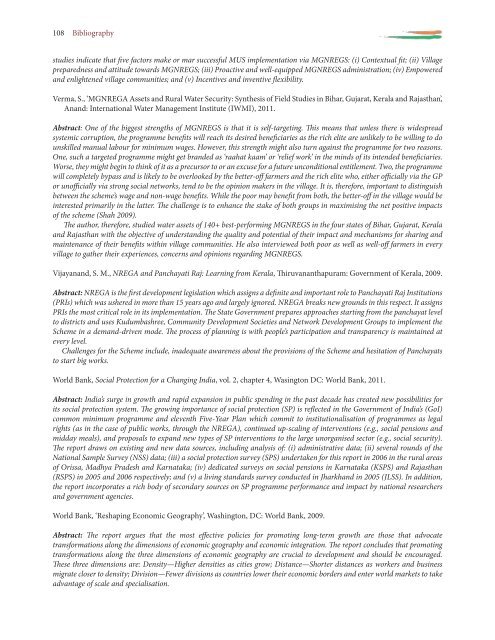MGNREGA_SAMEEKSHA
MGNREGA_SAMEEKSHA
MGNREGA_SAMEEKSHA
Create successful ePaper yourself
Turn your PDF publications into a flip-book with our unique Google optimized e-Paper software.
108 Bibliography<br />
studies indicate that five factors make or mar successful MUS implementation via MGNREGS: (i) Contextual fit; (ii) Village<br />
preparedness and attitude towards MGNREGS; (iii) Proactive and well-equipped MGNREGS administration; (iv) Empowered<br />
and enlightened village communities; and (v) Incentives and inventive flexibility.<br />
Verma, S., ‘<strong>MGNREGA</strong> Assets and Rural Water Security: Synthesis of Field Studies in Bihar, Gujarat, Kerala and Rajasthan’,<br />
Anand: International Water Management Institute (IWMI), 2011.<br />
Abstract: One of the biggest strengths of MGNREGS is that it is self-targeting. This means that unless there is widespread<br />
systemic corruption, the programme benefits will reach its desired beneficiaries as the rich elite are unlikely to be willing to do<br />
unskilled manual labour for minimum wages. However, this strength might also turn against the programme for two reasons.<br />
One, such a targeted programme might get branded as ‘raahat kaam’ or ‘relief work’ in the minds of its intended beneficiaries.<br />
Worse, they might begin to think of it as a precursor to or an excuse for a future unconditional entitlement. Two, the programme<br />
will completely bypass and is likely to be overlooked by the better-off farmers and the rich elite who, either officially via the GP<br />
or unofficially via strong social networks, tend to be the opinion makers in the village. It is, therefore, important to distinguish<br />
between the scheme’s wage and non-wage benefits. While the poor may benefit from both, the better-off in the village would be<br />
interested primarily in the latter. The challenge is to enhance the stake of both groups in maximising the net positive impacts<br />
of the scheme (Shah 2009).<br />
The author, therefore, studied water assets of 140+ best-performing MGNREGS in the four states of Bihar, Gujarat, Kerala<br />
and Rajasthan with the objective of understanding the quality and potential of their impact and mechanisms for sharing and<br />
maintenance of their benefits within village communities. He also interviewed both poor as well as well-off farmers in every<br />
village to gather their experiences, concerns and opinions regarding MGNREGS.<br />
Vijayanand, S. M., NREGA and Panchayati Raj: Learning from Kerala, Thiruvananthapuram: Government of Kerala, 2009.<br />
Abstract: NREGA is the first development legislation which assigns a definite and important role to Panchayati Raj Institutions<br />
(PRIs) which was ushered in more than 15 years ago and largely ignored. NREGA breaks new grounds in this respect. It assigns<br />
PRIs the most critical role in its implementation. The State Government prepares approaches starting from the panchayat level<br />
to districts and uses Kudumbashree, Community Development Societies and Network Development Groups to implement the<br />
Scheme in a demand-driven mode. The process of planning is with people’s participation and transparency is maintained at<br />
every level.<br />
Challenges for the Scheme include, inadequate awareness about the provisions of the Scheme and hesitation of Panchayats<br />
to start big works.<br />
World Bank, Social Protection for a Changing India, vol. 2, chapter 4, Wasington DC: World Bank, 2011.<br />
Abstract: India’s surge in growth and rapid expansion in public spending in the past decade has created new possibilities for<br />
its social protection system. The growing importance of social protection (SP) is reflected in the Government of India’s (GoI)<br />
common minimum programme and eleventh Five-Year Plan which commit to institutionalisation of programmes as legal<br />
rights (as in the case of public works, through the NREGA), continued up-scaling of interventions (e.g., social pensions and<br />
midday meals), and proposals to expand new types of SP interventions to the large unorganised sector (e.g., social security).<br />
The report draws on existing and new data sources, including analysis of: (i) administrative data; (ii) several rounds of the<br />
National Sample Survey (NSS) data; (iii) a social protection survey (SPS) undertaken for this report in 2006 in the rural areas<br />
of Orissa, Madhya Pradesh and Karnataka; (iv) dedicated surveys on social pensions in Karnataka (KSPS) and Rajasthan<br />
(RSPS) in 2005 and 2006 respectively; and (v) a living standards survey conducted in Jharkhand in 2005 (JLSS). In addition,<br />
the report incorporates a rich body of secondary sources on SP programme performance and impact by national researchers<br />
and government agencies.<br />
World Bank, ‘Reshaping Economic Geography’, Washington, DC: World Bank, 2009.<br />
Abstract: The report argues that the most effective policies for promoting long-term growth are those that advocate<br />
transformations along the dimensions of economic geography and economic integration. The report concludes that promoting<br />
transformations along the three dimensions of economic geography are crucial to development and should be encouraged.<br />
These three dimensions are: Density—Higher densities as cities grow; Distance—Shorter distances as workers and business<br />
migrate closer to density; Division—Fewer divisions as countries lower their economic borders and enter world markets to take<br />
advantage of scale and specialisation.


